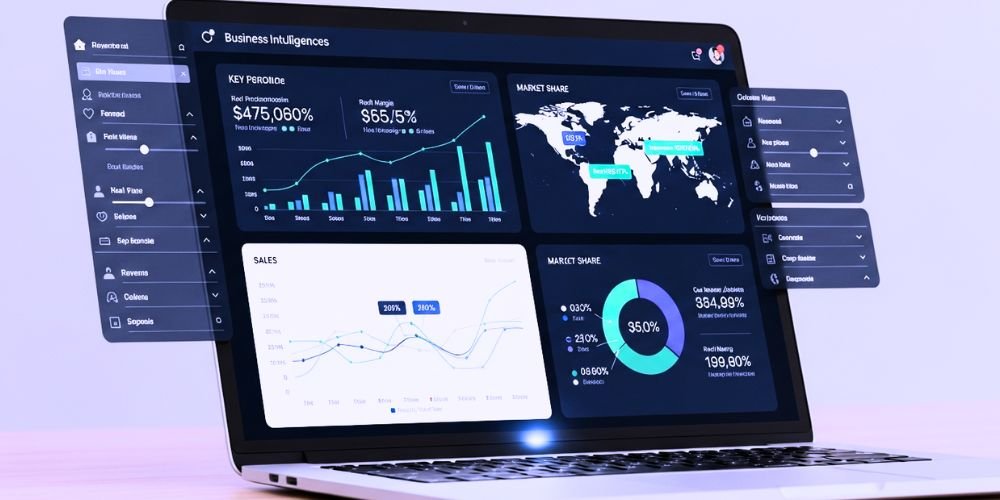Data has become a valuable asset for organizations across all industries in the digital age. Business Intelligence (BI) is the practice of harnessing this data to extract meaningful insights and support informed decision-making. This article explores the concept of Business Intelligence, its key components, and its impact on organizational success.
Understanding Business Intelligence
Business Intelligence refers to organizations’ processes, technologies, and strategies to collect, analyze, and interpret data to drive business performance. It involves gathering data from various sources, transforming it into meaningful information, and presenting it in a format that facilitates decision-making. Business Intelligence aims to enable organizations to make data-driven decisions, identify opportunities, and address challenges effectively. By utilizing advanced analytics and visualization tools, BI empowers organizations to transform raw data into actionable knowledge.
Key Components of Business Intelligence
Business intelligence comprises several key components essential in uncovering key insights and making informed decisions. First and foremost, data quality is crucial. Without accurate and reliable data, any insights gained from business intelligence tools will be flawed and potentially harmful to the organization.
Data Collection and Integration
Business Intelligence relies on collecting and integrating data from various sources, including internal systems, databases, external sources, and third-party providers. This data can include transactional records, customer information, market data, social media feeds, and more. Integrating disparate data sources enables a comprehensive view of the organization’s operations and external factors.
Data Warehousing and Storage
To support Business Intelligence processes, organizations utilize data warehousing solutions. Data warehouses serve as centralized repositories that store and organize data in a structured manner. These repositories facilitate efficient data retrieval and analysis, enabling users to access and analyze information across multiple dimensions and timeframes.
Data Analysis and Reporting
The heart of Business Intelligence lies in data analysis and reporting. Organizations employ various analytical techniques, such as data mining, statistical analysis, predictive modeling, and machine learning, to extract insights from the collected data. These insights are then transformed into visual reports, dashboards, and interactive visualizations, providing users with a clear understanding of the data and facilitating effective decision-making.
Data Visualization and Reporting Tools
It leverages data visualization and reporting tools to present complex data in a user-friendly and visually appealing format. These tools enable users to create charts, graphs, maps, and other visual representations that simplify data interpretation and enhance understanding. Interactive dashboards allow users to drill down into specific data points and explore different perspectives.
Business Performance Monitoring
Business Intelligence includes monitoring and tracking key performance indicators (KPIs) to evaluate business performance. By setting benchmarks and measuring performance against them, organizations can assess the effectiveness of their strategies and initiatives. Real-time monitoring and alerts enable timely responses to emerging trends or deviations from expected outcomes.
The Impact of Business Intelligence
The impact of business intelligence must be balanced. Businesses can make informed decisions that improve efficiency and profitability by utilizing data warehousing, mining, reporting, analytics, and dashboarding.
Informed Decision-Making
Business Intelligence empowers organizations to make informed decisions based on data-driven insights. By analyzing historical and real-time data, organizations gain a deeper understanding of market trends, customer behaviors, operational efficiencies, and financial performance. It enables executives and decision-makers to make strategic choices that align with organizational goals and drive success.
Competitive Advantage
It gives organizations a competitive advantage by enabling them to gain insights into market dynamics and customer preferences. Analyzing data can uncover patterns, identify growth opportunities, and support the development of effective marketing strategies. By leveraging Business Intelligence, organizations can make more informed decisions and stay ahead in a rapidly evolving business landscape.
Improved Operational Efficiency
Business Intelligence enables organizations to identify areas of inefficiency and optimize operational processes. By analyzing data related to resource allocation, production efficiency, supply chain management, and customer satisfaction, organizations can identify bottlenecks, streamline operations, and improve overall efficiency. It leads to cost savings and enhanced productivity.
Enhanced Customer Understanding
It enables organizations to gain a deeper understanding of their customers. Organizations can identify trends, preferences, and patterns by analyzing customer data and behavior, allowing for more targeted marketing campaigns, personalized experiences, and improved customer satisfaction. It leads to stronger customer relationships and increased customer loyalty.
Proactive Risk Management
It enables organizations to identify and mitigate potential risks. Organizations can identify potential risks and take proactive measures to reduce them by analyzing market conditions, industry trends, and internal operations. It helps minimize financial losses, manage regulatory compliance, and address operational vulnerabilities.
Conclusion
Business Intelligence empowers organizations to unlock the full potential of their data, enabling informed decision-making, driving operational efficiencies, and fostering a data-driven culture. Organizations gain insights into market dynamics, customer behaviors, and operational performance by collecting, integrating, analyzing, and visualizing data.
With the ability to make data-driven decisions, organizations can gain a competitive edge, optimize processes, enhance customer experiences, and mitigate risks. Embracing Business Intelligence as a core organizational practice is essential for organizations to thrive in today’s data-driven world.













